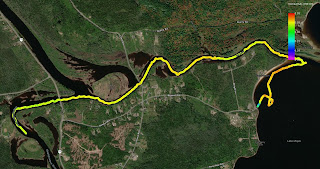The last couple of weeks have been quite busy getting the first commercial order for an AMOS Board Kit ready for shipment. The order came from South Korea, so the first order of business was trying to find a safe and legal way to ship the 12 V, 10 AH LiFePO4 (lithium iron phosphate) battery by air. This unfortunately consumed a number of days trying to contact local dangerous goods shippers, checking out dangerous goods shipping courses, and then trying to see if there might be some way to find the same (or a similar) battery locally. Eventually a local reseller of the same battery was found, but purchasing the battery required a Korean phone number (for security reasons?) which I did not possess. So the final solution was to simply give the customer a discount and recommend they buy the battery themselves from the local reseller.
A stock unit was mostly ready for the sale, but a fish finder (for measuring depth) and solar panel needed to be added, and some extra wiring was required. These parts arrived after about a week and the wiring was completed, the magnetometer calibrated, and the unit made ready for testing just in time for the long weekend. We had made plans to go to my parents' cottage in Cap Brule for the long weekend, but could not get there until Saturday night. Sunday was rainy and very windy, with gusts up to 70 km/hr, so no testing could be performed that day. The following day was less windy (20 km/hr) but the cold waves outside the cottage were still a few feet high and smashing against the rocks. Not an ideal location to launch a small kids' foam surfboard. Fortunately the river in town in Shediac was more sheltered, so I took the boat over there. It went through a planned grid course very nicely, although the wind and current did blow it off course a little bit in the middle parts of the river:








